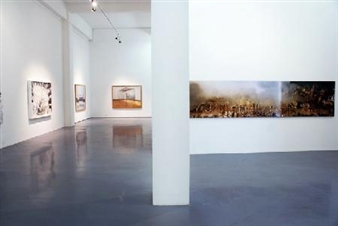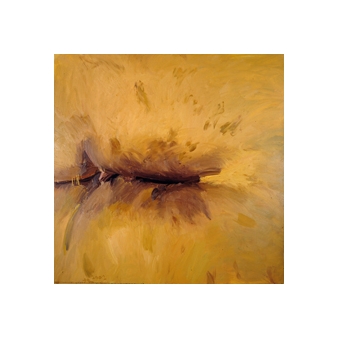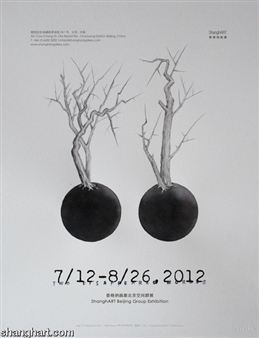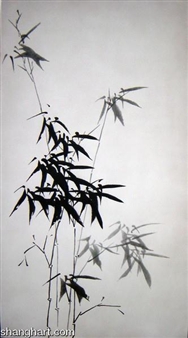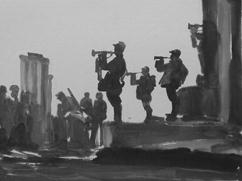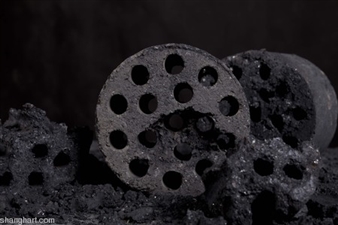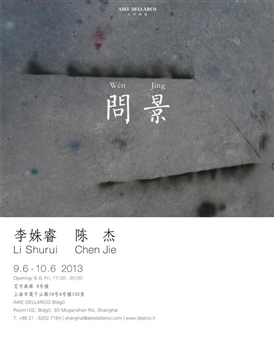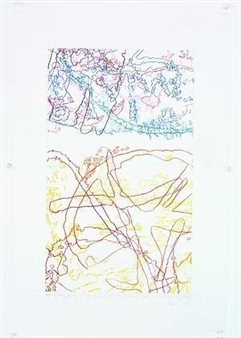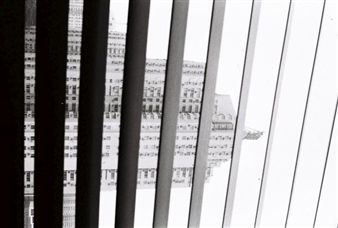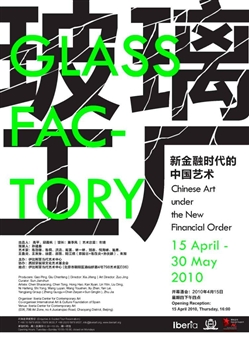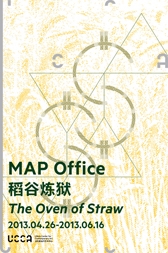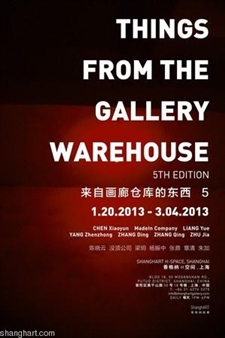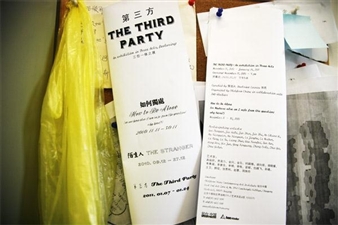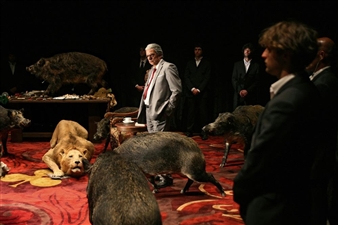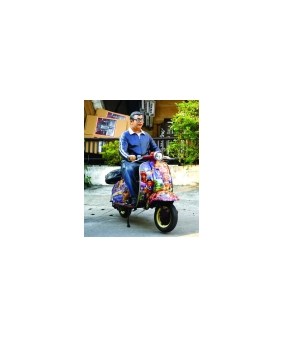The Other There:Solo Exhibition of Gao Shiqiang / No World - View for the Face:Solo Exhibition of Dong Wensheng
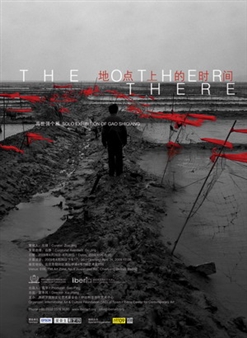
Iberia Center for Contemporary Art, Beijing, Beijing, 04/26/2009 - 06/20/2009
Zone E06, 798 Art District, No.4 Jiuxianqiao Rd., P.O. Box 100015-87
A brief introduction of the exhibit: Gao Shiqiang is one of the recent “scholarly” artists in the field of Chinese contemporary art. Gao’s work, which includes installations, photographs and experimental films, carries a sense of broadness and complexity towards the reflection and bodily experience of daily life—such qualities are rarely found amongst his peers. His practice also hints at a systematic way of conceiving works. His recent pieces move away from the narrow confines of competing ways of thinking, and in turn, he brought a way of conceiving Chinese history and culture to new heights. Dong Wensheng’s work also freely crisscrosses between installation, photography and experimental films. His work frequently includes elements of Chinese tradition with a strong link to characteristics related to the region of Jiangnan. His highly individualistic pieces often transpose the viewer into a paradoxical realm that hovers between the traditional past and the contemporary present; Dong is interested in infusing his spectators within a state of tragic psychological sadness. Gao Shiqiang is an active young artist who has participated at numerous important Asian art exhibitions, such as the Shanghai Biennale, the Guangzhou Triennial, the Gwangju Biennale, and the Chinese Art Triennial Exhibition. Dong Wensheng has exhibited at a number of important international institutes, such as the P.S.1 Contemporary Art Center (New York), the Kunsthalle Wien (Vienna), and at the Institut Valencià d'Art Modern (Valencia). This exhibition is their first solo shows in Beijing that also presents a number of their recent pieces Foreword Zuo Jing After “What Has Been Happening Here? : Inaugural Exhibition of Chinese Independent Film Archive (CIFA)”, Iberia Center for Contemporary Art is presenting “‘The Other There’: Solo Exhibition of Gao Shiqiang”, and “‘No World-View for the Face’: Solo Exhibition of Dong Wensheng”. These two solo exhibitions attempt to showcase some of the most recent changes occurring in the contemporary art field – artists born in the 1970s are becoming prominent and are rewriting the history of contemporary art. The range of mediums they employ have broadened. Among these mediums, video and installation have become their most important languages. They are re-examining history as a whole and in the process reveal their complicated and conflicting feelings regarding the subject matter. They do not hesitate to show their obsession with traditions, and they attempt to pick up the knowledge tradition, which derives from both ancient and modern times, from where it has been left off. With conscience and courage to destroy the existing macro narrative, they attempt to create their own grand narratives based on their imagination, and accept the possibilities that these narratives may subject to failure. They attempt to integrate knowledge from various fields of humanities and digest them in fragments, and a unique scholarly quality thus taking on in their art practice. The last but not the least, they are passionate about the search for and verification of new values. Gao Shiqiang was born in 1971. He currently teaches at the Department of Experimental Art of the China Academy of Art in Hangzhou. In 1995, along with Lu Lei and Gao Shiming, Gao Shiqiang co-founded a creative group and began an art practice that they called “Situational Sculpture”. During this time, symbolic meanings concerning psychological, social and cultural aspects began to emerge in their works due to interactions with various complex contexts and intertextual relationships with them, thus seeking a departure from being overly dependent on conceptualism. In 1996, with video installation The Visible and Invisible Life, they participated in “Phenomenon/Images: The First Chinese Video Art Exhibition”. Several years after, Gao moved to Shanghai to pursuit his master's degree and later returned to his Alma Mater for teaching in 2003. He began to work independently and started the Hangzhou Video Movement with his friends Chen Xiaoyun, Lu Lei, Wu Junyong, Sun Xun, and Ni Keyun, among others. This is a group-based Contemporary Art Movement that is extremely rare today. At the same time, his creative works had entered a second stage – “Video Sculpture”. During this period he created a large amount of experimental short films. Given his educational background in the Art Academy, instead of relating these pieces to the history of experimental films, it is perhaps more accurate to view them as works constructed by the means of contemporary art. These works also present a “return to Classicism” in creative techniques. From 2007 to present, Gao's artistic career have entered a third stage - a thriving phase dominated mostly by films. The subject matters he explored range from an ancient folklore mutated in the modern time (Butterfly Lovers), personal life and historic memories (Big Bridge), personal reflections of the Communism Movement (Red), theatrical experiments (Revolution), as well as experiments that hint towards anthropological films (Faint with Oxygen and The Other There). While preserving the experimental nature of his works, the form of these pieces is returning to traditional art films and displays a tendency towards elitism. In terms of content, the recognition of and reflection on history and reality presented in these works are broader and more complex than many other works created by artists of Gao's generation. With tendencies to be systematic, Gao’s works bring the thinking on Chinese history and culture to a new height. They break free from the narrow disputes of ideological arguments, and reflect the dramatic changes of a post-socialist society – a transformation of a country-based and community-based collective to a space with individual rationales and personal goals at its core. And during this transformation, Gao's generation is inwardly constructing personal traditions and value system of their own. Different from Gao Shiqiang’s attempt to construct a large-scale system of inquiry and questioning, Dong Wensheng (b. 1970) focuses on the re-discovery of the aesthetics that originates from the Jiangnan region. From my point of view, this re-discovery represents a nostalgic yearning and recognition for tradition in a “post-traditional” society. And in a certain sense, this re-discovery is a meaningful process of cultural “restoration” in an attempt to avoid the “state of self torn by desperation”. In the field of contemporary art, the word “Jiangnan” seems to be a word that is associated with a region or with a geologically-related subject; but essentially, “Jiangnan” is directly and integrally related to the contextualization of the Chinese tradition. Its merit and charm is increasingly being regarded as significant by those who are interested in the geist of the Chinese tradition. Up until now, Dong’s work maintains a close relationship with the city of Changzhou in the Jiangnan region where he’s living. His practice crisscrosses freely between photography, installation and experimental film, and he ingeniously uses elements that symbolize what one would consider as representations of Chinese traditional culture, such as “garden”, “rock”, “tattoo”, “skeleton”, “moss”, etc. From the early backyard garden and still life series, to the more recent photographs that utilize human bones as his main subject, Dong’s work has evolved from focusing mainly on the mysterious, the surreal, and sometimes the bizarrely and sexually-charged situations, to an abstract meditation on philosophical questionings such as time, existence, and nothingness. Dong’s experimental short films fully capture the soft and effeminate qualities of the Jiangnan aesthetics. His work Jingzhe (The Awaking of Insects) conveys a tragic lament to the fading of tradition; clearly, this work is influenced by the sad and depressing literary figures—who existed in the mist of the clashing interweave between the old and the new—as typified in the work of Yu Dafu, a prominent writer and poet of the 1930s in China. Meiyu (Plum Rain) and Xiaoshu (Slight Heat) are two short films that focus on the topics of sexual awakening and the growth of life. Their documented scenes are captured in an austere fashion that fully exposes the poetic “wetness” of the region of Jiangnan. Dong’s most important video work—The Moment of Stone Sinking—uses a naturalistic style to express the entanglement between a contextualized tradition and a globalized contemporary society that is under development. This work also touches on the urge for resistance towards the constructed ideology of a modernized city. What deserves to be mentioned above all is the title for Dong’s exhibition, No World-view for the Face, comes from Zhao Tingyang’s book No World-view for the World. In Zhao’s book, a type of Chinese “view beneath the heaven” is constructed that differs from the world-view of the West. This coincides with Dong’s attempt to establish a new kind of root and value system in the re-thinking of traditional Chinese thoughts—perhaps this is the dream and the glory that are being sought-after by artists of this generation.
For More Information